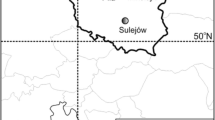Abstract
In this study, the performance of M5 model tree and conventional method for converting pan evaporation data (Ep) to reference evapotranspiration (ET0) were assessed in semi-arid regions. Conventional method uses pan coefficient (Kp) as a factor to convert Ep to ET0. Two common Kp equations for pans with dry fetch (Allen et al. 1998; Abdel-Wahed and Snyder in J Irrig Drain Eng 134(4):425–429, 2008) were considered for the comparison. The values of ET0 derived using these three methods were compared to those estimated using the reference FAO Penmane Monteith (FAO-PM) method under semi-arid conditions of the Khuzestan plain (Southwest Iran). The results showed that the M5 model is the best one to estimate ET0 over test sites (0.5 mm d−1 of root mean square error (RMSE) and 0.98 of coefficient of determination (R 2). Conversely, the performance of the two Kp equations was poor.






Similar content being viewed by others
References
Abdel-Wahed MH, Snyder RL (2008) Simple equation to estimate reference evapotranspiration from evaporation pans surrounded by fallow soil. J Irrig Drain Eng 134(4):425–429
Allen RG, Pruitt WO (1991) FAO-24 reference evapotranspiration factors. J Irrig Drain Eng 117(5):758–773
Allen RG, Pereira LS, Raes D, Smith M (1998) Crop evapotranspiration. Guidelines for computing crop water requirements. In: FAO irrigation and drainage paper, no 56. FAO, Roma, Italy
Bhattacharya B, Solomatine DP (2005) Neural networks and M5 model trees in modeling water level–discharge relationship. Neurocomputing 63:381–396
Bhattacharya B, Solomatine DP (2006) Machine learning in sedimentation modelling. Neural Netw 19(2):208–214
Chauhan S, Shrivastava RK (2009) Performance evaluation of reference evapotranspiration estimation using climate based methods and artificial neural networks. Water Resour Manag 23(5):825–837
Cuenca RH (1989) Irrigation system design: an engineering approach. Prentice-Hall, Englewood Cliffs
Doorenbos J, Pruitt WO (1977) Guidelines for prediction of crop water requirements. FAO Irrig Drain. Paper No. 24, Rome
Frevert DK, Hill RW, Braaten BC (1983) Estimation of FAO evapotranspiration coefficients. J Irrig Drain Eng 109(2):265–270
Irmak S, Haman D, Jones W (2002) Evaluation of class A pan coefficients for estimating reference evapotranspiration in humid location. J Irrig Drain Eng 128(3):153–159
Jensen ME (1974) Consumptive use of water and irrigation water requirements. Irrig Drain Div Rep ASCE N Y 89:15–41
Jensen MC, Middleton JE, Pruitt WO (1961) Scheduling irrigation from pan evaporation. Circular 386, Washington Agricultural Experiment Station
Mitchell TM (1997) Machine learning. The McGraw-Hill Companies, Inc., New York, NY, pp 414
Pal M, Deswal S (2009) M5 model tree based modelling of reference evapotranspiration. Hydrol Process 23:1437–1443
Quinlan JR (1992) Learning with continuous classes. In Proceedings of the Fifth Australian Joint Conference on Artificial Intelligence, Hobart, Australia, 16–18 November, World Scientific, Singapore: 343–348
Raghuwanshi NS, Wallender WW (1998) Converting from pan evaporation to evapotranspiration. J Irrig Drain Eng 118(6):977–980
Sabziparvar AA, Tabari H, Aeini A, Ghafouri M (2010) Evaluation of Class A Pan Coefficient Models for Estimation of Reference Crop Evapotranspiration in Cold Semi-Arid and Warm Arid Climates. Water Resour Manag 24(5):909–920
Snyder RL (1992) Equation for evaporation pan to evapotranspiration conversions. J Irrig Drain Eng 118(6):977–980
Solomatine DP, Dulal KN (2003) Model trees as an alternative to neural networks in rainfall-runoff modelling. Hydrol Sci J 48(3):399–411
Solomatine DP, Xue Y (2004) M5 model trees compared to neural networks: application to flood forecasting in the upper reach of the Huai River in China. J Hydrol Eng 9(6):491–501
Tabari H (2010) Evaluation of reference crop evapotranspiration equations in various climates. Water Resour Manag 24:2311–2337
Trajkovic S, Kolakovi S (2010) Comparison of Simplified Pan-Based Equations for Estimating Reference Evapotranspiration. J Irrig Drain Eng 136(2):137–140
Trajkovic S, Kolakovic S (2009) Evaluation of reference evapotranspiration equations under humid conditions. Water Resour Manag 23:3057–3067
Wang Y, Witten IH (1997) Induction of model trees for predicting continuous lasses. In: Proceedings of the Poster Papers of the European Conference on Machine Learning. University of Economics, Faculty of Informatics and Statistics, Prague
Witten IH, Frank E (2005) Data Mining: Practical Machine Learning Tools and Technique. Morgan Kaufmann Publishers, San Francisco, pp 560
Author information
Authors and Affiliations
Corresponding author
Rights and permissions
About this article
Cite this article
Rahimikhoob, A., Asadi, M. & Mashal, M. A Comparison Between Conventional and M5 Model Tree Methods for Converting Pan Evaporation to Reference Evapotranspiration for Semi-Arid Region. Water Resour Manage 27, 4815–4826 (2013). https://doi.org/10.1007/s11269-013-0440-y
Received:
Accepted:
Published:
Issue Date:
DOI: https://doi.org/10.1007/s11269-013-0440-y




